Bearn was France’s first aircraft carrier. Through a combination of bad design and bad luck, it had no effect on the outcome of WWII. However it had an interesting and important, if quiet, life after WWII. 
(Bearn just prior to WWII.)
Origin and Design
Bearn was supposed to be the final member of the five-ship Normandie battleship class. A flawed design, all were cancelled during construction however the incomplete hull of Bearn was launched in April 1920, both to clear the building dock at La Seyne shipyard, and, in the hopes that some use might later be found for the hull. At the same time, a group of French officers were shown the Royal Navy’s HMS Argus and France decided to convert Bearn into the country’s first aircraft carrier. The conversion was not easy and finally completed on 1 September 1926. Bearn did not actually commission until 1928. Bearn was named for a province of France.
Bearn displaced 28,400 tons and measured 599’1″x115’6″x30’6″, with a crew of 43 officers and 832 enlisted sailors. The propulsion system was weird and caused problems throughout the ship’s life. The outer two propeller shafts were driven by SNFCM reciprocating steam engines, and the inner two shafts by Parsons geared steam turbines. There was a 4,500hp difference between an inner and an outer shaft. All four engine sets were run by a shared steam plant of six Normand du Temple boilers.
As this was France’s first aircraft carrier, there was no experience to go on and Bearn had some strange features. The flight deck was contoured to match the shape of the bow and stern, even there was no real reason requiring it. The flight deck overall measured 590’9″ however the rear portion was sloped downwards, in the thought that a plane coming in too low might “ride it up” to the flight deck instead of smacking into the transom. Likewise, the forward tip of the flight deck was sloped down a lesser angle. Both angled portions were essentially wasted space.  (A Wibault 74 comes in for a landing aboard Bearn prior to WWII. The stern casemate guns can be clearly seen as well.)
(A Wibault 74 comes in for a landing aboard Bearn prior to WWII. The stern casemate guns can be clearly seen as well.)
The flight deck was wooden planks over a 1″ steel deck. There were no catapults. Bearn commissioned without arresting wires; to land, a plane had to hook a rope weighed down with sandbags. This incredibly dangerous idea was eliminated when the Schneider company quickly designed France’s first arresting gear.
 (A PL.4 plane catches an arresting wire aboard Bearn before WWII. The amidships and aft elevators are visible.)
(A PL.4 plane catches an arresting wire aboard Bearn before WWII. The amidships and aft elevators are visible.)
There were three electric elevators which were amazingly complicated. Two halves of an upper door articulated upwards, allowing a separate platform to bring the plane up. The plane was pushed off the platform, which was then lowered below, and the doors shut. To lower a plane to the hangar reversed the process. This arrangement had several problems. Every carrier design with centreline elevators runs the risk of a down-jam, rendering the flight deck unusable. But on Bearn, even if the elevators had an up-jam, it would equally block the flight deck. Because a plane could not sit on the platform in the raised position, a ballet of sorts was needed when using all three elevators at the same time, pushing planes up, off, and out of the way on the flight deck’s limited space.
 (Bearn’s amidships elevator upper doors closing.)
(Bearn’s amidships elevator upper doors closing.)
 (Another weird feature was a system which convected outside air into the stack, so that the exhaust smoke was cooled when it reached the top. The goal was to eliminate a “halo” of thermal updrafts which followed the ship and annoyed pilots. This system was a failure.)
(Another weird feature was a system which convected outside air into the stack, so that the exhaust smoke was cooled when it reached the top. The goal was to eliminate a “halo” of thermal updrafts which followed the ship and annoyed pilots. This system was a failure.)
The hangar deck was actually decently designed. It measured 408’5″x64′ and had 2 ½” steel armor. There was a separate smaller “second hangar” below for additional planes.
 (Vought V-156-F dive bombers in Bearn’s hangar.)
(Vought V-156-F dive bombers in Bearn’s hangar.)
Like many navies before WWII, the French had a wrong concept of the aircraft carrier’s role in the fleet. The ship was designed for surface gunnery battles, which an aircraft carrier is totally unsuited for. There were eight Mle.1920 155mm anti-ship guns in armored casemates; these guns had no AA ability and very restricted firing arcs even against surface targets. Casemate guns went in and out of fashion in the early 20th century; by the late 1920s they were recognized as nearly useless and were being removed worldwide; even as Bearn was just entering service.
Due to the hull’s battleship origin, there was a 3″ armor belt around the hull; again; fairly useless on an aircraft carrier. One of the more bizarre features was a small deckhouse which could project up from the flight deck for surface combat (it was later deleted).
Amazingly, Bearn was fitted with four 22″ anti-ship torpedo tubes. The whole aircraft carrier had to turn to “aim” a torpedo shot and they were even more useless than the casemate guns. The only other armament was six Mle.1926 75mm AA guns, which were slow-firing and obsolete.
(The two port side forward 155mm casemate guns can be seen here. These weapons were nearly useless aboard an aircraft carrier. The oval on the sloped part of the forward deck is where the pop-up deckhouse was.)
Combined with the strange engine set-up, the weight of the belt armor and casemate guns limited Bearn to just 21kts. Even this speed could only be maintained for short periods. This was completely insufficient for the war that was to come and the slow speed put not only the carrier, but her escorts as well, in danger. The slow speed, more than anything else, proved to be the ship’s biggest handicap.
Air wing problems
France’s efforts to work up an air wing for Bearn were a disaster. The ship was intended to carry 35 planes split into fighter, attack, and reconnaissance squadrons.
The original fighter was the Levy-Biche LB2 biplane. It was made of untreated wood and canvas and unsuitable for naval use, and was replaced after a year by obsolete Dewoitine D1C1s as a temporary fix. This “temporary” solution ended up lasting until October 1932 when the Wibault 74 came onboard. Armed with two Vickers 7.7mm machine guns, this open-cockpit parasol plane was decent for the early 1930s.
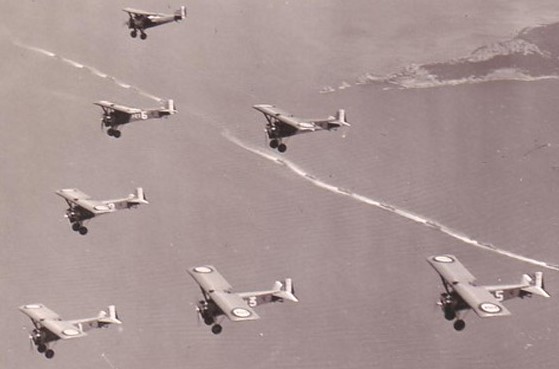 (The Wibault 74 had an air-cooled Lorraine 12EB piston engine and a top speed of 123kts.)
(The Wibault 74 had an air-cooled Lorraine 12EB piston engine and a top speed of 123kts.)
In February 1939, the Dewoitine D.376 replaced the Wibaults. It was not successful. By this time, France realized they had underestimated the rise of the Luftwaffe and were desperately trying to catch up, and all planes were destined for the French air force. Bearn‘s air wing was the least of the country’s worries and the carrier’s fighter squadron was eliminated altogether.
The original attack plane was the Levasseur PL.4 biplane. In June 1930, an upgraded model, the PL.7, replaced it. This plane had a terrible safety record and was actually grounded for a while.
(A PL.7 of Escadrille 7B2, Bearn’s attack squadron, lets go a Mle.26DA anti-ship torpedo before WWII.)
When they weren’t grounded, the slow, open-cockpit PL.7s served aboard Bearn through the 1930s. No suitable replacement was produced by French industry and in frustration, the French navy bought an off-the-shelf private design from the American company Vought. The V-156-F was a quality, well-built dive bomber with a Pratt & Whitney R-1535 piston engine and a top speed of 203kts.
 (The US Congress allowed the export of Vought’s V-156-F to France, but blocked export of the bomb bay mechanism on national security grounds. The French were forced to make do with two external bombs.)
(The US Congress allowed the export of Vought’s V-156-F to France, but blocked export of the bomb bay mechanism on national security grounds. The French were forced to make do with two external bombs.)
The V-156-F was well-liked by Escadrille 7B2 and remained in use as Bearn‘s main combat asset. Despite the rushed, off-the-shelf buy, it was the best plane of any sort which Bearn ever operated.
Bearn‘s reconnaissance squadron was initially equipped with the obsolete Gourdou-Leseure 22. These were replaced by simply adding cameras to the existing PL.7. Due to that type’s problems, it was in turn replaced by the PL.10, and then the PL.101 which could also carry bombs. All of these biplanes were obsolete and in 1939, the Nieuport LN40 attack plane was scheduled to be both a common replacement for the PL.101 reconnaissance and V-156-F dive bomber types. However the French government decided they were more urgently needed ashore and none were ever based aboard Bearn.
(A LN40 comes in for a test landing aboard Bearn several weeks before the start of WWII.)
Oddballs
(As an experiment, a tailhook was fitted to a Potez 56 transport. This was the first time in history that a twin-engine plane landed on a ship.)
(The Leo 30 autogyro was the first rotary-wing aircraft to land on a French warship.)
Eve of WWII
By the end of 1938, France realized that Bearn was a flop and ordered two Joffre class carriers to replace Bearn. Neither was built due to WWII. So as war approached in September 1939, the lumbering Bearn remained France’s lone carrier, now missing both her fighter and reconnaissance squadrons. Just before the war, additional light AA guns were added.
(Bearn just prior to the declaration of war in September 1939, and the ship’s original crest.)
Bearn during WWII
Bearn‘s one and only combat patrol came during the war’s first few weeks in 1939. It was a bungled operation to locate Germany’s pocket battleships.
 (Bearn departing Brest naval base during WWII, prior to the fall of France.)
(Bearn departing Brest naval base during WWII, prior to the fall of France.)
All of the ship’s shortcomings became painfully clear and the French decided to temporarily give up on carrier operations altogether. In late September 1939, Bearn made a unique voyage, transporting some of France’s gold bullion to North America. After returning, Bearn was sent to the Mediterranean Sea where it was planned to conduct training flights to rebuild the air wing.
On 10 May 1940, Germany began the attack on the Low Countries and France. Bearn‘s V-156-F dive bombers (the only aircraft still onboard) were sent ashore to help in the desperate situation. This was despite the fact that the naval aviators had never been trained on overland attack missions. Three V-156-Fs were shot down by Luftwaffe fighters and a fourth by AA guns. The survivors retreated south to the French Riviera. When Italy joined the attack on France, a half-dozen more were destroyed on the ground. The remaining V-156-Fs fled to Corsica where their pilots abandoned them.
Meanwhile, the now-empty Bearn was loaded for a second gold bullion run. The plan was to deliver the gold to Canada and then load American-manufactured land-based planes, to ferry them to the French air force. In June 1940, the American-built planes loaded onboard at Halifax, NS. During the return voyage, Bearn was notified by radio that all of France’s Atlantic ports would be overrun and the carrier was diverted to France’s Caribbean island of Martinique to await further orders. On 25 June 1940, France surrendered. Bearn was moored at Fort-au-France naval base at Martinique. The governor of the tiny island was pro-Vichy, meanwhile the crew of Bearn was split between pro-Vichy and pro-de Gaulle feelings.
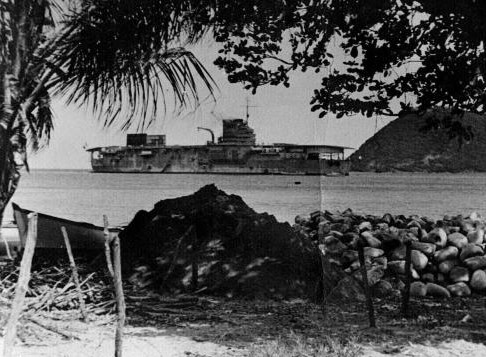 (Bearn in the Caribbean Sea. This photo shows how the strange elevators blocked the flight deck, even when in the up position. The ship is not camouflaged, just rusty and filthy.)
(Bearn in the Caribbean Sea. This photo shows how the strange elevators blocked the flight deck, even when in the up position. The ship is not camouflaged, just rusty and filthy.)
The land based aircraft were still onboard and, lacking instructions, it was decided to unload them. None of Bearn‘s crew was trained in ashore aircraft preservation, and the planes were simply put in a muddy field. In the humid Caribbean weather, they quickly rotted away. None ever flew again.
 (Brewster Buffalo fighters on Martinique, part of Bearn’s abandoned cargo. These planes lacked tailhooks and could not have operated off the ship.)
(Brewster Buffalo fighters on Martinique, part of Bearn’s abandoned cargo. These planes lacked tailhooks and could not have operated off the ship.)
The Royal Navy was concerned about having a possibly hostile carrier on the loose, and the cruiser HMS Dunedin was assigned to the area with orders to sink Bearn if she tried to leave the Caribbean. Eventually, Admiral Georges Robert, the highest-ranking French naval officer on the island, struck a quiet “gentleman’s agreement” with the British that Bearn would make no hostile moves if the British agreed not to attack her pierside in Martinique.
For the rest of 1940 and most of 1941, Bearn did nothing. The atmosphere onboard the ship (which lacked air conditioning) was not pleasant; the crew was stuck on a little island in a different hemisphere than France, with divided loyalties, an uncertain future, and the threat of a British attack. The carrier had not received maintenance since May 1940 and was beginning to deteriorate.
The USA entered WWII in December 1941. President Roosevelt was not thrilled about the Martinique’s pro-Vichy stance, and in 1942 there was consideration given in the USA to sink Bearn and occupy the island. Luckily this did not happen, and the ship was left quarantined at Martinique.
In July 1943, the governor of Martinique switched allegiances and joined the Free French. The head of the Free French naval team in the USA requested American help in getting Bearn back into the fight. The US Navy had a negative opinion of the ship; due to the slow top speed, age, and strange features. In August 1943, the US Navy told the Free French that the ship would be unusable as an aircraft carrier but that the United States would pay to convert Bearn into an airplane ferry.
On 8 September 1943, Bearn left Martinique for the first time since the summer of 1940, bound for Avondale Shipyards in New Orleans LA. There, an extensive rebuild was done. The angled ends of the flight deck were cut off, and a safety barrier erected around what remained. The arresting wires were removed. The amidships elevator was ripped out and replaced with a fast cargo elevator. An American-design cargo crane was added to the port side.
(Bearn after the conversion to airplane ferry. The flight deck has been truncated, the searchlight atop the island removed, the armament changed, and radar installed. The ship is painted US Navy-standard Measure 32 camouflage.)
All French-made weapons, including the useless casemate guns, were deleted. In their place, four Mk12 5″, six Mk4 quad 40mm, and twenty-six smaller (20mm and .50cal) AA guns were installed. A CXBE radar was installed, as were US Navy-standard radios. Finally the hull and machinery was cleaned and maintained. The crew size was significantly reduced, to 27 officers and 624 enlisted sailors.
(Bearn’s main armament after the New Orleans refit, Mk12 5″ and Mk4 40mm guns.)
(Bearn in the USA after conversion to airplane ferry, with the aft flight deck cropped off and American-made guns fitted.)
Shipyard space for large vessels was limited in the USA and conversion of a foreign navy’s airplane ferry was a very low priority. Work was not completed until 30 December 1944. In the early spring of 1945, Bearn moved to New York City and loaded her first cargo of land-based planes. Bearn had another episode of bad luck shortly after, colliding with a merchant ship. The ex-carrier did not return to France until March 1945, just before WWII in Europe ended.
Bearn after WWII
The Indochina War
The former aircraft carrier received some repairs in France during the summer of 1945, and was then immediately assigned to CEFEO, the combat force fighting communists in French Indochina. In October 1945, Bearn departed Europe ferrying land-based aircraft, spare parts, and supplies to Indochina. Along the way, Bearn stopped in Singapore where some WWII-veteran landing craft were purchased from the Royal Navy and loaded aboard; these were later converted into river combat boats.
 (Bearn unloading aircraft at Ha Long, Indochina (today in Vietnam) in late 1945. The box-shaped port side crane, installed in the USA during the WWII conversion, is in use as is the original curved French crane on the starboard side.)
(Bearn unloading aircraft at Ha Long, Indochina (today in Vietnam) in late 1945. The box-shaped port side crane, installed in the USA during the WWII conversion, is in use as is the original curved French crane on the starboard side.)
 (An ex-Imperial Japanese Navy Aichi E13A “Jake” seaplane is serviced aboard Bearn in Indochina. A number of these were collected by the French navy in Indochina after Japan’s surrender and placed into French use for several years, mostly operating out of Cat Lai near Saigon. This photo shows the quick-acting stores elevator which replaced the amidships aircraft elevator during the WWII refit in the USA.)
(An ex-Imperial Japanese Navy Aichi E13A “Jake” seaplane is serviced aboard Bearn in Indochina. A number of these were collected by the French navy in Indochina after Japan’s surrender and placed into French use for several years, mostly operating out of Cat Lai near Saigon. This photo shows the quick-acting stores elevator which replaced the amidships aircraft elevator during the WWII refit in the USA.)
Bearn remained in Indochina until June 1946, supporting both aircraft and ship repairs. The ship also served as a floating barracks. In June 1946, Bearn departed Indochina and headed back to Europe.
 (Rusty from the time in Indochina, Bearn returns to Toulon, France on 23 July 1946.)
(Rusty from the time in Indochina, Bearn returns to Toulon, France on 23 July 1946.)
Cold War submarine tender
When Bearn returned to France in July 1946, the ship’s future was unclear. Obviously Bearn would never serve as an aircraft carrier again, and the aging ship was expensive to operate as a plane ferry. On 1 October 1946, Bearn was decommissioned and placed into mothballs.
At that time, the French navy was rebuilding it’s submarine arm in the Mediterranean Sea and the barracks situation in Toulon was becoming urgent. Many of the base’s barracks had been destroyed during WWII and what remained was old and overcrowded. It was proposed to reactivate Bearn as a submarine tender and floating barracks, as there were hundreds of berths on board and the ship would also be ideal for storing equipment of the submarine force. Bearn recommissioned on 9 December 1948.
(A torpedo is hoisted from Bearn to the French submarine Bouan in 1950. Bouan itself was a WWII veteran war prize, having previously been the German Kriegsmarine’s U-510 during the war.)
 (Bearn in Toulon during the early 1950s, with a variety of French submarines. The radar had already been removed off Bearn by this time.)
(Bearn in Toulon during the early 1950s, with a variety of French submarines. The radar had already been removed off Bearn by this time.)
For her new role as a barracks ship, Bearn was not fully manned, as it was not anticipated to get the vessel underway often if ever. The weapons were left in mothballs and unmanned. Some of the compartments onboard were used as administrative offices by the 1st submarine squadron, and the hangar deck was used for storage. The new pennant number was A601, which was never painted onto the sides of the hull.
 (Bearn in Toulon during the mid-1950s.)
(Bearn in Toulon during the mid-1950s.)
Bearn‘s use as a barracks ship was only supposed to be temporary. However due to funding shortfalls from the Algerian war and Suez episode, no new ashore barracks were built and Bearn continued on as the inport home for French submariners in the Mediterranean.
 (Bearn in 1964. By this time all weapons had been stripped off the old ship. The two markings on the aft part of the flight deck are GPIs (glide path indicators) so that helicopter pilots of inport destroyers could practice landings.)
(Bearn in 1964. By this time all weapons had been stripped off the old ship. The two markings on the aft part of the flight deck are GPIs (glide path indicators) so that helicopter pilots of inport destroyers could practice landings.)
 (The submarines Amazone and Arethuse next to Bearn in Toulon in 1966. The four Arethuse class submarines were a quality design. They commissioned between 1958-1960 and served France into the 1980s. Their sleek lines make a good contrast with the pre-WWII look of Bearn.)
(The submarines Amazone and Arethuse next to Bearn in Toulon in 1966. The four Arethuse class submarines were a quality design. They commissioned between 1958-1960 and served France into the 1980s. Their sleek lines make a good contrast with the pre-WWII look of Bearn.)
In 1966 a new barracks building, Caserne L’Herminier, opened in Toulon and crews of the stationed submarines began to move in. There was no further need for Bearn and preparations were started to dispose of the ship. By this time, the old Bearn was no longer capable of getting underway due to the age of the engines.
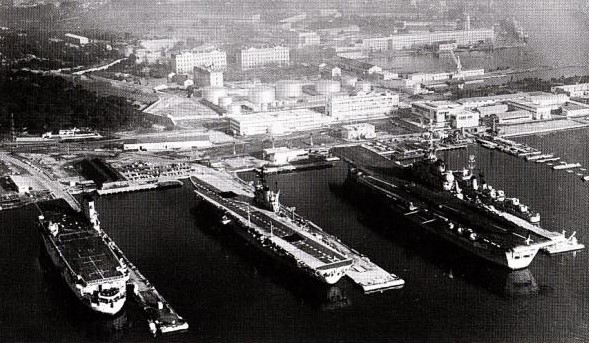 (A fairly remarkable 1966 picture of Toulon naval base showing three generations of French flat-tops: Bearn of WWII, Arromanches of the Indochina and Suez wars, and the then-new Clemenceau which many years later served in Desert Storm and the 1990s Balkan conflicts.)
(A fairly remarkable 1966 picture of Toulon naval base showing three generations of French flat-tops: Bearn of WWII, Arromanches of the Indochina and Suez wars, and the then-new Clemenceau which many years later served in Desert Storm and the 1990s Balkan conflicts.)
 (The quiet hull of Bearn in 1966 several months before being sold as scrap. At the time, Bearn held the record for the longest-serving aircraft carrier still in commission in any role.)
(The quiet hull of Bearn in 1966 several months before being sold as scrap. At the time, Bearn held the record for the longest-serving aircraft carrier still in commission in any role.)
Bearn was decommissioned for a final time on 21 March 1967. Later that year, the hulk was sold as scrap. It was towed to Savona, Italy and scrapped there over the 1967-1968 winter. This was the end of France’s first aircraft carrier, which never launched a single combat sortie but still gave 40 years of good use.

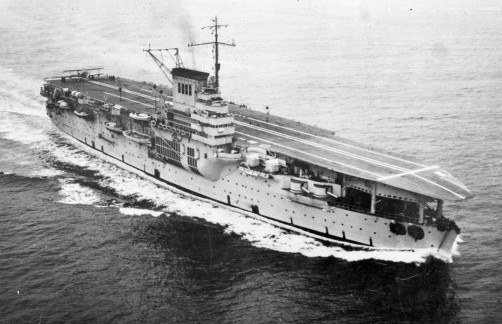





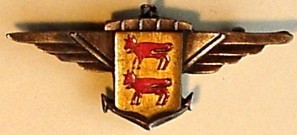

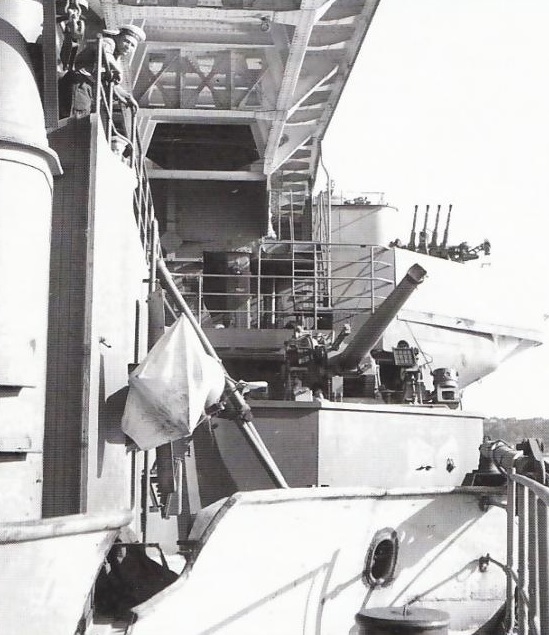


Well written & Informative !!
LikeLiked by 1 person
This article has information that I’ve seen nowhere else in 20 years of researching this ship, including the archives of the U.S. Navy.
LikeLiked by 1 person
Aloha Graehame, I would like to use part of your article for an article I’m writing for Sea Classics Magazine. I will give you full attribution. I am also willing have you as a co-author and split all publication payments with you? Please get back to me.
George Massengale
LikeLike
Excellent article.
LikeLiked by 1 person
One of the most bizarre and unusual warships ever built in the 20th century.
LikeLike
…the V-156 was the French version of the Vought SB2U Vindicator, which didn’t have a bomb bay in the first place. They both swung an underbelly bomb past the propeller with a trapeze mechanism. Where do you get this information??
LikeLike
Yes you are correct. What I was referring to was the propeller clearance brace (the “bomb cradle”); I phrased that really bad when I called it a bomb bay mechanism. That one is on me.
LikeLike
Just found out that the Bearn was fitted with four 550mm fixed underwater torpedo tubes – have any other aircraft carriers been armed with torpedo tubes?
LikeLike
I think some of the BB / CB conversions may have originally had them, but I am not aware of any other flattop that kept them or were designed with them. Its not really a practical setup IMO.
LikeLike